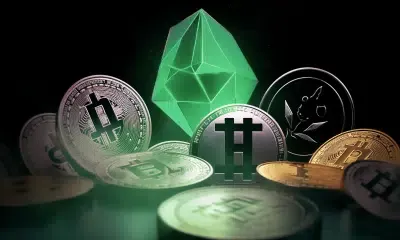
To really get a grip on digital assets, you’ve got to tell apart its main players: coins and tokens. People throw these terms around like they’re the same, but how they’re born, how they work, and what they mean for anyone building, investing, or just using them couldn’t be more different.
Spotting the Key Difference: Coins vs. Tokens
Think of a crypto coin, or what many call a cryptocurrency, as the home-grown currency of its very own, standalone blockchain. Bitcoin (BTC) operates on the Bitcoin blockchain, and Ether (ETH) is native to Ethereum’s; these are classic examples. These aren’t just digital assets; they’re the fundamental building blocks of the networks they belong to.
Tokens, on the other hand, are more like digital applications built to run on blockchains that already exist. You’ll find them on platforms like Ethereum (which is famous for ERC-20 tokens), BNB Smart Chain (with its BEP-20 tokens), or Solana. Instead of constructing their own foundational layer, tokens lean on the security and operational framework of their host blockchain.
Route One: Crafting Your Own Crypto Coin (and its Native Blockchain)
If you’re dreaming of creating a coin, you’re signing up to either build a whole new blockchain from scratch or to take an existing one and fork it—both paths are serious undertakings, heavy on technical skill and resources.
The Nitty-Gritty of Building:
- Starting Fresh with a New Blockchain: This means you’re literally designing a new digital ledger system from the ground up. You’ll need deep knowledge in areas like cryptography, how distributed systems operate, and coding languages such as C++, Rust, or Go. You’ll face major design choices:
- Picking a Consensus Method: You have to decide how transactions get confirmed and the network stays secure. This involves choosing and putting in place systems like Proof-of-Work (PoW), which Bitcoin made famous but uses a lot of energy, or Proof-of-Stake (PoS), which is more energy-friendly and used by networks like Ethereum (after its big Merge) and Cardano. Other options like Delegated Proof-of-Stake (DPoS) or Proof-of-Authority (PoA) offer different balances between speed, spread-out control, and security.
- Shaping the Blockchain’s Structure: Will your blockchain be open for anyone to see and use (public), restricted (private or consortium-based), or require permission to join (permissioned versus permissionless)? These are foundational questions.
- Building the Node Network: You’ll need to set up and keep a widespread network of computers (nodes) all running your blockchain’s software.
- Taking a Shortcut by Forking: This path involves grabbing the open-source code of a blockchain that’s already out there (like Bitcoin’s) and tweaking it to spin off a new, separate chain with its own coin (Bitcoin Cash is an example). It might sound quicker, but you’ll still need a good amount of technical know-how to make sure everything works securely and as intended.
What This Means for Your Strategy:
- Total Freedom: As the creator, you get the final say on everything: your coin’s special features, how it’s governed, and its money rules (like Bitcoin’s limited supply, Ether’s pre-Merge tendency to create more coins, or systems that “burn” coins to reduce supply).
- Hefty Investment of Time and Money: Getting a custom blockchain designed, launched, and then kept running smoothly costs a lot.
- You Carry the Security Weight: It’s entirely up to you to keep the network safe, fending off things like 51% attacks (where someone controls most of the network) and Sybil attacks (fake identities). If your chain can run smart contracts, getting those checked by experts is absolutely crucial.
- The Challenge of Attracting a Crowd: Drawing in enough users, developers, and people to validate transactions or mine new coins to create a lively, strong ecosystem is a big mountain to climb.
- Wading Through Regulations: You’ll have to keep up with the constantly changing rules around the world for things like preventing money laundering (AML/KYC), whether your coin counts as a security, and how it’s taxed. These rules can be very different depending on where you are.
Route Two: Designing a Token on an Existing Blockchain
Creating a token is often the more straightforward option, as you get to use the rails of blockchains that are already well-established.
The Nitty-Gritty of Token Making:
- Simpler Path to Development: Putting a smart contract onto a host blockchain like Ethereum usually doesn’t involve the same level of complexity or expense as coin creation.
- Using Token Blueprints: Working with well-known standards (like ERC-20 for tokens that are interchangeable, or ERC-721 for unique items like NFTs) means your token will easily work with existing digital wallets, exchanges, and decentralized apps (dApps).
- Helpful Tools and Platforms: While it helps to know your way around smart contract languages (Solidity is key for chains compatible with Ethereum’s setup), there’s a growing number of tools and platforms out there that can make generating a token much easier, sometimes with very little coding needed.
What This Means for Your Strategy:
- Lighter on Development Resources: You’ll generally spend less money and get to market faster.
- Borrowed Security: Your token gets to benefit from the safety and proven network of the blockchain it lives on.
- Plugged into an Ecosystem: Your token can immediately interact with the wide array of services and users already on the host blockchain.
- Tied to the Host: How well your token performs, how much transactions cost (the “gas fees”), and how quickly things can scale are all up to the host chain. If Ethereum gets busy, for example, using ERC-20 tokens can become expensive due to high gas fees.
- Less Room to Customize: You’re working within the limits and rules set by the host blockchain’s design.
- A Wide Range of Possibilities: Tokens can do all sorts of jobs: they can grant access to a product or service (utility), give voting power (governance), represent ownership of an asset (security, which comes with very strict rules), or hold a steady value (stablecoins).
When you look at what’s under the hood, a coin runs on its own custom-made blockchain, completely independent. Tokens, however, are crafted using smart contracts that live on someone else’s blockchain. This difference naturally makes building a coin a much tougher job, demanding you figure out the whole blockchain structure and how everyone agrees on transactions.
Tokens are simpler; you’re mostly just getting a smart contract up and running. Consequently, getting a coin off the ground will hit your wallet harder and eat up more of your calendar than launching a token. If you go the coin route, you call all the shots on how it works, its features, and even how money flows. With a token, you play by the rules and limitations of the blockchain it’s built on.
Securing a coin means you’re on the hook for protecting the entire network. Token creators get to piggyback on the security already proven by the host blockchain. You’ve seen coins like Bitcoin (BTC), Ether (ETH), and Cardano (ADA) out in the wild. For tokens, think of things like USDT (an ERC-20), SHIB (another ERC-20), or CAKE (a BEP-20).
Key Things to Nail Before Launching Your Crypto Asset
First off, before you even think about launching a new crypto asset, ask yourself: what makes it special? In a field packed with options, your coin or token needs a truly unique reason to exist. What knotty problem does it untangle that others don’t? If it doesn’t have a solid use in the real world, it’s likely to just become another speculative blip, not something people will actually use and value long-term. Many crypto ventures fizzle out precisely because they skip this crucial step; some studies even show that more than half the cryptocurrencies born since 2021 are already dead and buried.
Then, you absolutely must get the economics—the tokenomics—right from the start, as this is the heart of your project.
- Think carefully about how many coins or tokens will ever exist. Will there be a fixed amount like Bitcoin, which helps build its “digital gold” story? Or will it be inflationary, or perhaps deflationary, like how Ethereum’s EIP-1559 update started burning some Ether, tightening its supply?
- You’ll also need a solid plan for how these assets get into people’s hands initially. Will you do an ICO, IEO, or IDO? Aim for a fair launch? Or maybe airdrop them to build community? The goal here is to spread them out fairly and encourage a decentralized network.
- And don’t forget vesting schedules. For tokens given to the team and early backers, setting up a timeline for when they can actually sell them is smart. It keeps everyone focused on the long haul and stops big, early sell-offs that can hurt the price.
Your development choices and security measures are next on the critical list.
- Regarding the tech you’ll use, C++, Rust, and Go are common for building the core of a blockchain, while Solidity is the go-to for smart contracts on Ethereum-like chains. Toolkits such as Substrate or the Cosmos SDK can give you a leg up if you’re building a custom chain.
- Getting independent security experts to pick apart your smart contracts and blockchain code isn’t just a good idea; it’s a must-do. This helps catch weaknesses that hackers could exploit, a problem that has unfortunately hit the DeFi world hard many times. These audits aren’t cheap, potentially running anywhere from $5,000 to over $100,000 depending on how complex your project is.
Be realistic about the price tag for creation and launch. You’ll need to set aside money for the actual development (anywhere from $5,000 to well over $100,000), those crucial security audits, getting legal advice ($10,000 to $50,000 or more isn’t uncommon), spreading the word through marketing ($10,000 to $50,000+), and maybe even fees to get listed on exchanges (these can vary wildly, from a few thousand dollars to over a million for the biggest centralized exchanges). If you go for a decentralized exchange (DEX), you’ll have costs tied to providing liquidity.
Don’t underestimate the maze of rules and legal stuff you’ll need to get through. This includes AML/KYC (anti-money laundering/know your customer) rules like the FATF Travel Rule, laws about whether your asset is a security (like the Howey Test in the U.S.), taxes, and even intellectual property concerns like open-source licensing and trademarks. Having a good lawyer is indispensable here. The rules are always shifting, with new frameworks like the EU’s MiCA aiming to provide clearer, broader regulation.
Building a community, marketing effectively, and planning for growth are also paramount.
- You need a passionate and active community—often found on platforms like Discord, Telegram, and Twitter—because they’re the ones who will adopt your project and help it spread.
- For marketing, you’ll need a strategy that uses multiple channels like creating good content, public relations, social media, and maybe even working with influencers (but choose them very carefully!) to get noticed in such a noisy market.
- Getting your asset listed on exchanges—whether big centralized ones (like Binance or Coinbase at the top tier, or smaller ones) or decentralized ones (like Uniswap or PancakeSwap)—is key for people to buy, sell, and access it. Each type of exchange has its own set of requirements and strategic pluses and minuses.
And the work doesn’t stop at launch; you need a plan for what comes next. To keep succeeding, you’ll need to keep improving the software, maintaining the network, encouraging other developers to build on your platform with grants and tools, making smart partnerships to find new uses for your asset, and always keeping your community involved and excited.
Keep an eye on how new trends are shaking things up. Areas like DeFi (decentralized finance), NFTs (non-fungible tokens), GameFi (gaming finance), and the Metaverse are really influencing how new coins are designed. You can bet we’ll see more coins made specifically for these new digital worlds, with a big focus on being able to work across different blockchains (using tools like CCIP or LayerZero), having more sophisticated smart contract abilities, and being governed by DAOs (decentralized autonomous organizations).
Choosing your monetary policy is a huge decision. Will you opt for a fixed supply, which can make it feel like a store of value (think Bitcoin)? Or a supply that grows over time in a planned way, which can help fund development or reward users and might be better for something used in everyday transactions? Or perhaps a deflationary approach, where tokens are “burned” to make them scarcer (like with EIP-1559)? Each choice has big ripple effects on the economics and tech, influencing how users behave and how valuable people think the asset will be in the long run.
It pays to learn from what’s happened before. Projects like Ethereum (which focused on real utility) and BNB (which built value within its ecosystem) took off. In stark contrast, look at failures like Terra/LUNA (whose algorithmic stablecoin had a fatal flaw) or BitConnect (which was just a Ponzi scheme). The big lessons here are to build something genuinely useful, design sustainable economics, make security a top priority, be open and honest, and follow the rules. Steer clear of promising pie-in-the-sky returns and focus instead on building something solid from the ground up.
Bringing a new crypto coin or token into the world is a massive challenge. To make it work, you need a mix of clever tech, smart economic planning, rock-solid security, sharp marketing, a supportive community, and a commitment to doing things ethically and by the book. The journey is tough, no doubt, but for projects that are well thought out, there’s a real chance to make a meaningful mark on the ever-changing digital economy.




